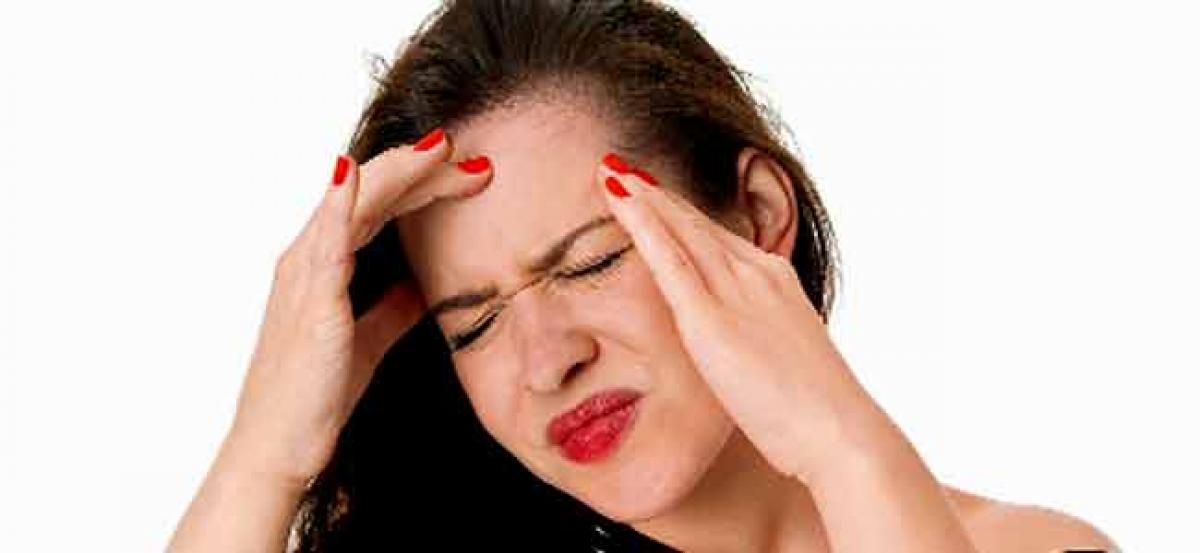Live
- Abhishek Bachchan's Marriage Rumors, Vivek Oberoi's Luxury Car, and BLACKPINK's Solo Success – Here's What's Trending!
- Party will decide if I need to continue or move out, says BJP's Kerala chief Surendran
- Coronation of Nathdwara MLA Vishvaraj Singh as Mewar's 77th successor starts amid question mark over palace visit
- WhatsApp Outage: Global Users Face Issues with Messaging App on Web
- Post-poll violence breaks out in Jharkhand after announcement of results
- Spiking to be made criminal offence: British PM
- MP CM in UK to woo investors thanks High Commission, diaspora for support (Ld)
- India's Stunning 295-Run Victory Over Australia: Bumrah and Siraj Lead Charge
- Chinese rocket debris reenters atmosphere, mostly burning up
- Winter Session of Parliament Begins with Key Bills and Heated Debates
Just In

Migraine is one of the leading and serious health problems in women as compared to men. There are different reasons or combination of reasons
Migraine is one of the leading and serious health problems in women as compared to men. There are different reasons or combination of reasons which lead to migraine such as stress, lack of sleep, alcohol, irregular eating habits, weather change etc. But it occurs more chronically and periodically in the women of age group 18-45, which can also be considered as peak reproductive age. This high prevalence and recurrence of migraine in women can be attributed to the changing hormone level in women especially during periods. For some women, migraine attacks occur during periods, or just before periods. It starts at any time from two days before, to three days after the first day of a period. This condition causes attacks of headaches, and often other symptoms such as feeling sick (nausea) or vomiting. During childhood, migraine is more prevalent in boys than in girls. But after puberty, the prevalence rises in girls and increases until age 40 or so, when it begins to decrease.
Causes
Studies have shown that migraine can be triggered by a fall in oestrogen levels, such as naturally occurs around menstruation. However, oestrogen is not the only hormone responsible for ‘menstrual’ migraine. Women who notice migraine during the first few days of their period may be susceptible to the hormone prostaglandin. This hormone is at its highest level in the body during a period, particularly in women who have heavy or painful periods, and can be associated with headache. It involves a number of brain chemicals, known as neurotransmitters, altering the effect of hormones such as oestrogen.
Types
There are two types of patterns observed:
Pure menstrual migraine: When migraine attacks happen only around period, and not at other times. This occurs in about one in seven women who have migraine.
Menstrual-associated migraine: When migraine attacks does not only happen around period, but also in other times of month. About six in 10 women who have migraine have this type of pattern.
Migraine attacks become more severe and frequent, as women approach menopause as level of oestrogen tends to go up and down at this time. However, once past the menopause, oestrogen level will be low and stable, and migraine attacks tend to reduce.
Diagnosis
Sometimes a period and a migraine attack (episode) occur at the same time by chance. Therefore, to make the diagnosis, a doctor suggests keeping a migraine diary for three months or so. This helps to see the pattern of migraine attacks, and whether one have menstrual migraine.
Treatment
Menstrual Migraine can be treated naturally and by medications. For optimum outcome the combination of both are beneficial.
Natural remedy
• Healthy diet- Eat right and eliminate processed food.
• Sleep – Getting six-eight hours of sleep is very important especially during periods
• Stress Management- Find ways to cope with PMS-related mood fluctuations and eliminate stress by involving in activities like yoga, meditation, exercise etc.
• Hydration- Drink about three liters of water every day to prevent dehydration.
Medical remedy
While reviewing these, remember that all medications have side effects and it’s very important to consult with your doctor. The treatment options are the same as for any other migraine attack, but it can further be adjusted. The options include:
• The most common- Painkillers, anti-inflammatory painkillers, antinausea medicines and triptan medicines.
• Oestrogen supplements- Topping up oestrogen level just before and during period is an option. This works because the trigger is thought to be a fall in the blood level of oestrogen before a period. Oestrogen skin patches are sometimes used. Patches are stuck on skin for seven days starting from three days before the expected first day of period. The oestrogen travels through the skin into the bloodstream. This is like having hormone replacement therapy (HRT) just for seven days each month. Unlike long-term HRT, provided periods are regular, one needn’t take progesterone medicine along with ogestrogne. An alternative is to use an oestrogen gel over skin which is absorbed into blood stream.
• Contraceptives- Hormonal contraceptives are a useful option if menstrual migraine is a problem and when women also need contraception.
• Recent studies have shown that drop in the serum iron levels soon after menstrual period may be a trigger for headaches and iron supplements may help control headaches.
(The writer is a Consultant, Headache Clinic Fortis Hospital )
Dr Jayasree Kailasam

© 2024 Hyderabad Media House Limited/The Hans India. All rights reserved. Powered by hocalwire.com







